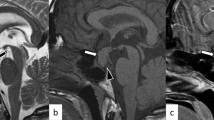Abstract
A case of a 66-year-old obese women with type 11 diabetes mellitus and a 4 year history of virilism is presented. After removal of the ovaries the raised testosterone levels returned to normal and signs of virilism gradually receded. The histological finding of nodular hyperthecosis of the ovaries is discussed in relation to hyperinsulinaemia.
Similar content being viewed by others
References
Breckwoldt M, Zahradnik HP, Wieacker P (1989) Hirsutism, its pathogenesis. Hum Reprod 4:601–604
Geisthovel F, Moretti-Rojas I, Rojas FJ, Asch RH (1990) Insulin-like growth factors and theca-granulosa cell function. Hum Reprod 5:785–799
Honore LH, Chari R, Mueller HD, Cumming DC, Scott JZ (1992) Postmenopausal Hyperandrogenism of Ovarian Origin. Gynecol Obstet Invest 34:52–56
Kuhn H, Taubert HD (1987) Das Klimakterium. Stuttgart G, Thieme
Nagmani M, Van Dinh T, Kelver ME (1986) Hyperinsulinaemia in hyperthecosis of the ovaries. Am J Obstet Gynecol 154:384–384
Novak ER, Woodruff JD (1979) Novak's Gynecologic and Obstetric Pathology. Philadelphia, Saunders
Nuovo GJ (1989) Virilizing stromal thecosis of the ovary associated with multiple corpora atretica. Am J Clin Pathol 92:505–508
Author information
Authors and Affiliations
Rights and permissions
About this article
Cite this article
Agorastos, T., Argyriadis, N., Fraggidis, G. et al. Postmenopausal virilization due to ovarian hyperthecosis. Arch Gynecol Obstet 256, 209–211 (1995). https://doi.org/10.1007/BF00634494
Received:
Accepted:
Issue Date:
DOI: https://doi.org/10.1007/BF00634494




